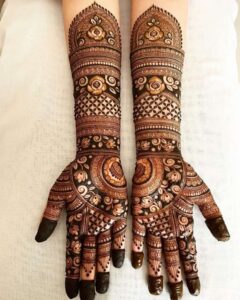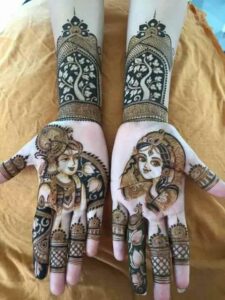DESCRIPTION OF BRIDAL MEHNDI DESIGNS

Bridal Mehndi designs hold a special place in Indian weddings, representing beauty, tradition, and cultural significance. These designs showcase intricate patterns and vibrant symbolism, enhancing the bride’s look and adding to the joyous occasion. Bridal Mehndi is not just about adornment; it carries deep meaning, connecting the bride to her heritage and expressing blessings for her new journey.

CREATE A DESIGNS
First, bridal Mehndi designs typically feature elaborate and detailed patterns, ranging from floral motifs to geometric shapes and symbolic symbols. Flowers, such as lotus and sunflower, are popular choices, representing purity, beauty, and new beginnings. Peacocks, another common motif, symbolize grace, love, and fertility. These symbols hold deep cultural significance and add a personal touch to the design, making it unique for each bride.

In addition, many brides opt for designs that reflect their love story. Artists often incorporate the groom’s name, portraits, or symbols of romance, like hearts, intertwined rings, or bridal vows. These touches make the Mehndi design a meaningful keepsake for the couple, adding an intimate layer to the wedding celebrations.

Moreover, intricate detailing in bridal Mehndi is a hallmark of the design. Bold lines outline the main motifs, while delicate, fine lines fill in the gaps with detailed patterns. This combination creates a striking contrast that adds depth and texture to the design. Symmetry plays a key role, with artists ensuring the left and right hands have balanced designs, or the design flows seamlessly from the hands to the arms and feet.

Additionally, while traditional bridal Mehndi uses natural brown henna, some brides choose to incorporate colorful accents. Colored mehndi cones, glitter, or even jewels can be added to enhance the design, creating a radiant, eye-catching effect.
Ultimately, bridal Mehndi designs are not just a form of decoration but a reflection of the bride’s cultural roots, personality, and emotions. These designs transform her into a canvas that tells a beautiful, intricate story, making her feel even more special on her big day.
